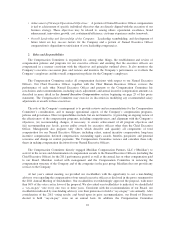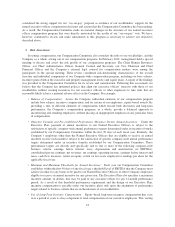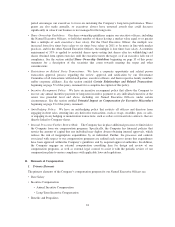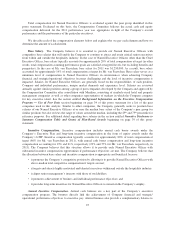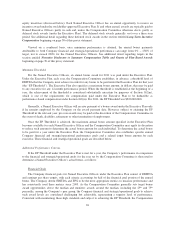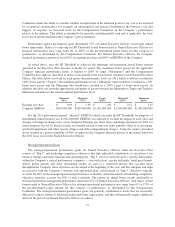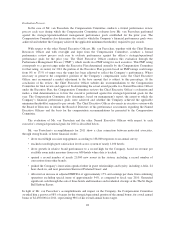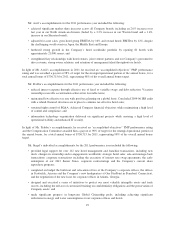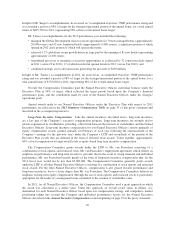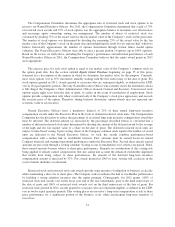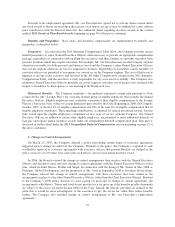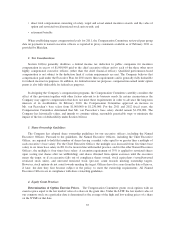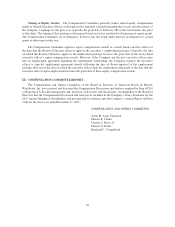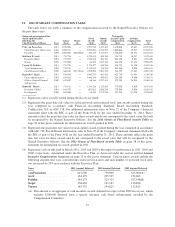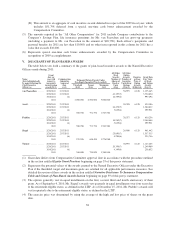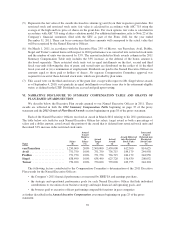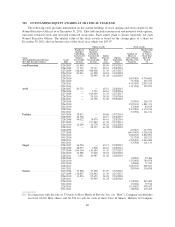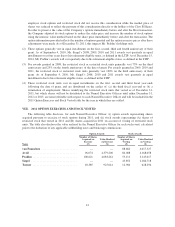Starwood 2011 Annual Report Download - page 41
Download and view the complete annual report
Please find page 41 of the 2011 Starwood annual report below. You can navigate through the pages in the report by either clicking on the pages listed below, or by using the keyword search tool below to find specific information within the annual report.The Compensation Committee determines the appropriate mix of restricted stock and stock options to be
given to our Named Executive Officers. For 2011, the Compensation Committee determined that a split of 75%
of restricted stock awards and 25% of stock options was the appropriate balance to maximize cost effectiveness
and encourage equity ownership among our management. The number of shares of restricted stock was
calculated by dividing 75% of the award value by the fair market value of the Company’s stock on the grant date.
The number of stock options was determined by dividing the remaining 25% of the award value by the fair
market value of the Company’s stock on the grant date and multiplying the result by two and one-half, which we
believe historically approximates the number of options determined through formal lattice model option
valuation. The Named Executive Officers were able to elect a greater portion of options (up to 100% options).
Based on the factors set forth above, including the Company’s performance and individual performance of each
Named Executive Officer in 2011, the Compensation Committee believes that the equity award grants in 2011
were appropriate.
The exercise price for each stock option is equal to fair market value of the Company’s common stock on
the option grant date. See the section entitled Equity Grant Practices beginning on page 35 of this proxy
statement for a description of the manner in which we determine fair market value for this purpose. Currently,
most stock options vest in 25% increments annually starting with the first anniversary of the date of grant. For
stock options granted in 2011, awards granted to associates who are retirement-eligible, as defined in the LTIP,
vest in 16 equal quarterly periods. The only Named Executive Officer who currently meets the retirement criteria
is Mr. Siegel, the Company’s Chief Administrative Officer, General Counsel and Secretary. Unexercised stock
options expire eight years from the date of grant, or earlier in the event of termination of employment. Stock
options provide compensation only when vested and only if the Company’s stock price appreciates and exceeds
the exercise price of the option. Therefore, during business downturns, option awards may not represent any
economic value to an executive.
Named Executive Officers have a mandatory deferral of 25% of their annual long-term incentive
compensation awards under the Executive Plan in the form of deferred restricted stock units. The Compensation
Committee has the discretion to reduce the percentage of an annual long-term incentive compensation award that
must be deferred. The deferred amount (as increased by the percentage described below) is converted into a
number of deferred restricted stock units determined by dividing the amount of the deferred award by the average
of the high and low fair market value of a share on the date of grant. The deferred restricted stock units are
subject to time-based vesting. Upon vesting, shares of the Company common stock equal to the number of vested
units are delivered to the Named Executive Officer. As such, the awards combine performance-based
compensation with a further link to stockholder interests. First, amounts must be earned based on annual
Company financial and strategic/operational performance under the Executive Plan. Second, these already earned
amounts are put at risk through a vesting schedule. Vesting occurs in installments over a three-year period. Third,
these earned amounts become subject to share price performance. Primarily in consideration of this vesting risk
being applied to already earned compensation (but also taking into account the enhanced stockholder alignment
that results from being subject to share performance), the amount of the deferred long-term incentive
compensation amount is increased by 33%. For awards granted in 2009 or later, vesting will accelerate in the
event of death, disability or retirement.
Restricted stock and restricted stock unit awards provide some measure of mitigation of business cyclicality
while maintaining a direct tie to share price. The Company seeks to enhance the link to stockholder performance
by building a strong retention incentive into the equity program. Consequently, for 2011 grants, 100% of
restricted stock unit awards vest on the fiscal year end of the year immediately prior to the third anniversary of
the date of grant and 100% of restricted stock awards vest on the third anniversary of the date of grant. For
restricted stock granted in 2011, awards granted to associates who are retirement-eligible, as defined in the LTIP,
vest in twelve equal quarterly periods. This vesting places an executive’s long-term compensation at risk to share
price performance for a significant portion of the business cycle, while encouraging long-term retention of
executives.
31



